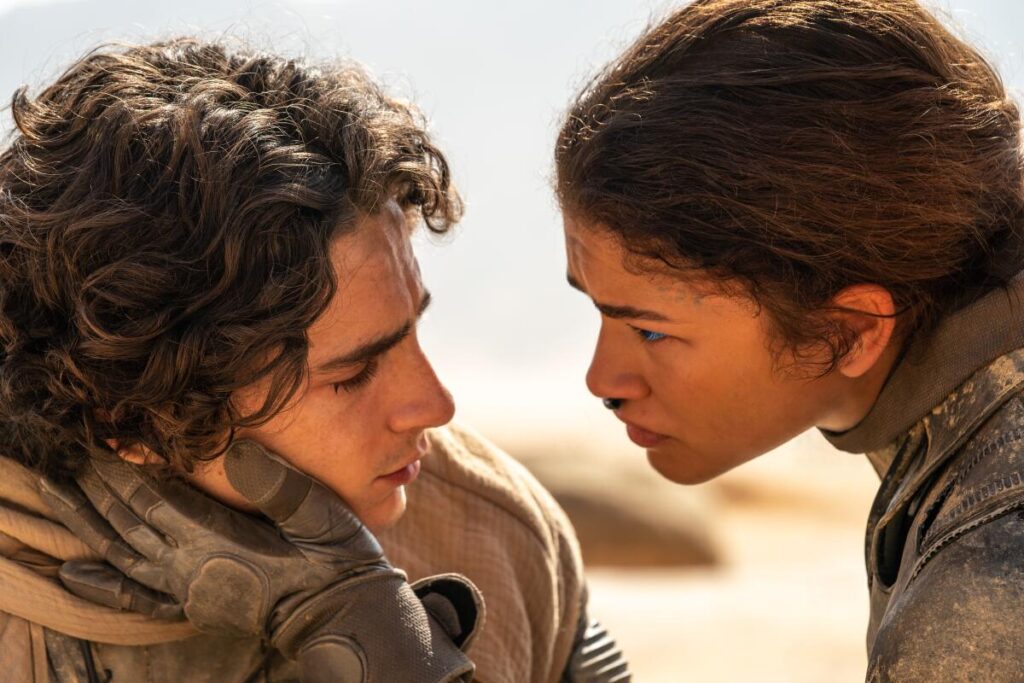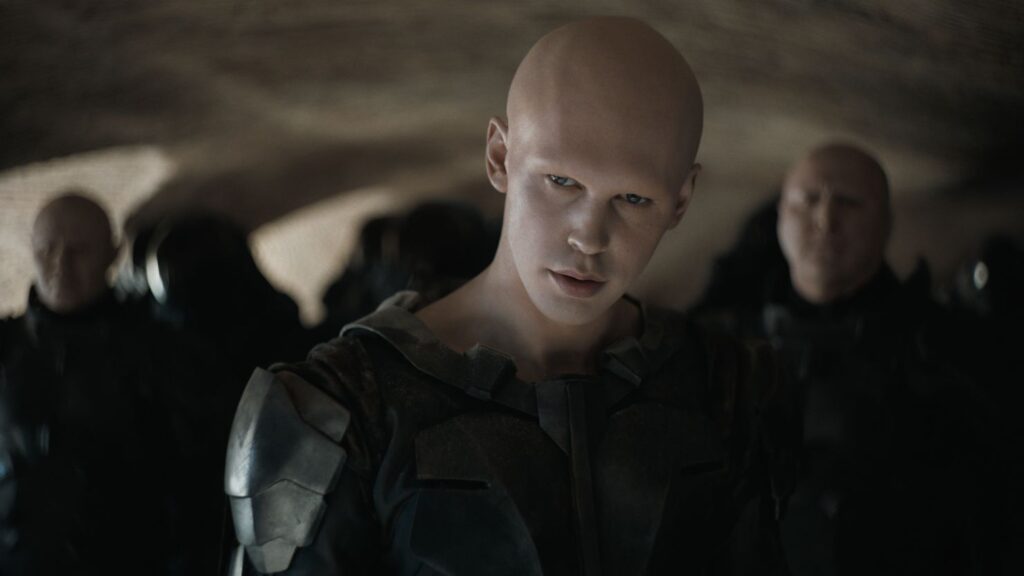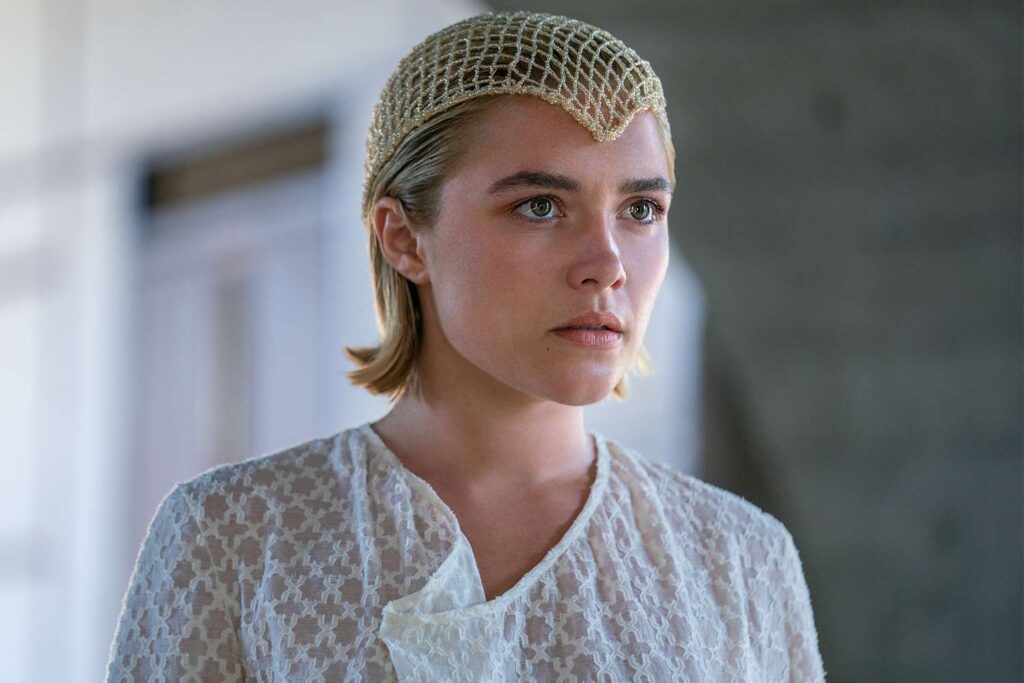
We know by now about the Sand Walk—that syncopated stroll across the desert whose arrhythmia helps you avoid detection from those monstrous worms. The irony of Denis Villeneuve’s Dune was that, despite its nominal exoticism, it delivered exactly what you anticipated: eye-popping visuals, grandiloquent design, and sonorous performances, all in the service of a predictable story that vacillated between diverting and tedious. You could be forgiven for expecting its sequel to provide more of the same; Dune was a critical and commercial hit, after all, and Hollywood tends not to mess with success. Yet the intervening years spent wandering the sands seem to have inspired Villeneuve, resulting in a richer and more thought-provoking follow-up. The happy surprise of Dune: Part Two isn’t that it’s good. It’s that it’s interesting.
Some of this may be a natural consequence of the source material; Villeneuve and his co-writer, Jon Spaihts, continue their adaptation of Frank Herbert’s novel, which I’ve never read but which presumably grows in complexity as it progresses. Still, regardless of the underlying inspiration, Dune 2 (or 2une, if you prefer) operates with a level of nuance that its predecessor lacked. The characters in the first movie were largely ciphers, secondary to the colossal world-building that preoccupied Villeneuve’s attention. They now feel like fully rounded people: emotionally fraught, yes, but also persuasively motivated and—in a note that’s unusual for blockbuster cinema—morally grey.

Not that Dune 2 skimps on spectacle. It remains a formidable feat of pop savvy—an impressive showcase of sweeping imagery, exacting detail, and muscular craft. From the opening set piece—which finds a squadron of black-clad foes impossibly launching themselves from the sand into the air, floating toward a rocky ridge in order to avoid a worm’s wrath—it’s plain that Villeneuve is once again tackling pulpy material with a satisfying blend of gravity and excitement.
Curiously enough, the thrills on display tend to be more moderate than enormous. Dune 2 remains a production of considerable scale, but the sense of sheer bigness that animated the first film has been replaced by an aesthetic that prioritizes texture over grandeur. As a result, some of the movie’s more boisterous set pieces, such as a dogfight in which scrappy ground-bound rebels do battle against pitiless airborne invaders, are more functional than breathtaking—a familiar cross between Mad Max: Fury Road and The Matrix Revolutions. Villeneuve is a gifted director, but his work here lacks the febrile imagination and visual flair of say, James Cameron’s Avatar pictures, or even his own Blade Runner 2049.

That’s an unfair standard, and besides, Dune 2’s subtle modulation works in its favor; its fine-grained splendor now feels more attuned to its characters, with their roiling desires and existential uncertainty. That’s why the movie’s most opulent sequence—a four-on-one gladiatorial skirmish that introduces Feyd-Rautha (Austin Butler, devouring scenery), the nephew of Baron Harkonnen (Stellan Skarsgård)—is virtually drained of color, like a demonic outtake from Spartacus. It’s a rip-roaring fight scene that also instantly establishes Feyd-Rautha as a sneering, psychopathic antagonist.
Feyd-Rautha may be a true-blue villain, but the heroes of Dune 2 are more complicated. The story picks up immediately after the rather abrupt ending of Dune, with Paul Atreides (Timothée Chalamet) and his mother, Jessica (Rebecca Ferguson), attempting to assimilate into the native Fremen of Arrakis, after the rest of their family was slaughtered by the Baron. (If you find that sentence indecipherable, I advise you to watch Dune again.) Their efforts receive a mixed reception. Many of the Fremen perceive Paul and Jessica as would-be colonizers who are not to be trusted, and who cannot learn their sacred ways. Chani (Zendaya), the blue-eyed beauty we met briefly last time out, regards Paul with a combination of suspicion and admiration, wary of his intentions but appreciating his bravery and apparent humility. And then there is Stilgar (Javier Bardem), who increasingly believes that Paul isn’t an ordinary person but is in fact the Lisan al Gaib—a messianic figure destined to lead the Fremen to prosperity.

What does Paul have to say about all of this? Initially, he is deferential and demure, insisting that he simply wants to live with the Fremen rather than command them. Yet as he grows more comfortable with their language and customs—including a rite of passage in which he rides an especially large sandworm, a sequence that is simultaneously goofy and spectacular, thanks to some absorbing effects and Villeneuve’s canny staging—Paul’s quest for peace begins to look more like a thirst for power. For her part, Jessica—a member of the Bene Gesserit, a sect of mighty priestesses who operate in the shadows, manipulating bloodlines and kings—literally drinks the Kool-Aid, imbibing some of the Fremen’s holy water and becoming their new Reverend Mother; she also converses with her fetus (voiced by Anya Taylor-Joy!), a sign of either clairvoyance or madness.
These developments grapple directly with themes that the prior picture merely glanced at: the ravages of colonialism, the draws and dangers of religious fundamentalism, the tension between personal desire and political power. It might sound odd for a movie that features giant worms and magic boxes to function as an interrogation of the white man’s burden, but the ideas at work in Dune 2 are urgent and real, even if they are also messy and unsettling. That sense of slipperiness is amplified by Chalamet’s nimble performance, which conveys an inner decency that is nonetheless fluid and corruptible. Chani, meanwhile, assumes the mantle of conscience, a heavy role that Zendaya infuses with the proper solemnity.

The heated, strained romance that inevitably ensues between Paul and Chani is just one of many subplots that Villeneuve crams into the film’s lengthy (but not baggy) 165 minutes. Elsewhere in the, er, galaxy (I’m a little fuzzy on the lexicon of this particular universe), a distressed emperor (Christopher Walken, questionably cast) frets about how to maintain his stranglehold on the realm, while his daughter (Florence Pugh, outfitted in a fabulous array of gold-and-silver chainmail) ruminates in her journal. Meanwhile, Feyd-Rautha feuds for the Baron’s favor with his older brother (Dave Bautista), a similarly violent if less clever brute; both of them exhibit the amusing, Vaderian penchant of haphazardly killing minions who dare speak to them. Feyd-Rautha also encounters Lady Margot (Léa Seydoux), another Bene Gesserit who is both seductive and deadly and who, in one of the movie’s most alluring scenes, cozies up to him in an ornate palace and overpowers him with her enchanting lethality.
There’s a lot going on, but Dune 2 never feels overstuffed, even if it also never quite achieves its sought-after sublimity. Villeneuve’s professionalism works in tandem with his sincerity, allowing the picture to exceed the sum of its sturdy parts. This is embodied in the movie’s climax which, rather than delivering one of those dreary large-scale assaults featuring thousands of computer-generated extras, instead centers on an intimate knife fight between Paul and Feyd-Rautha. Empirically speaking, it’s engaging but not exhilarating—crisply choreographed, pointedly personal, and far less invigorating than any random duel from John Wick. Yet it feels strangely monumental, like a coalescence of the film’s sifting conflicts and ideologies. That the simple dialogue scene which follows is equally potent is a testament to Dune 2’s strong characters and conceptual ambition. With the first Dune, Villeneuve reiterated his long-established bona fides as a showman. But in refining that lavishness with intelligence and maturity, he has now harnessed real desert power.
Grade: B+
Jeremy Beck is the editor-in-chief of MovieManifesto. He watches more movies and television than he probably should.
